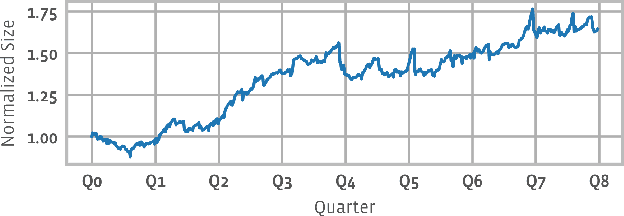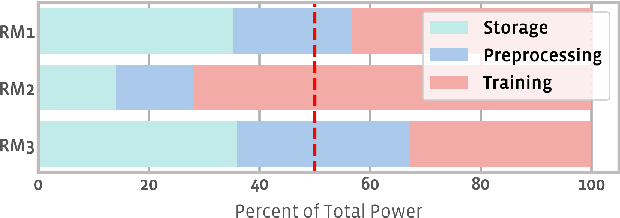Mark Zhao
Accelerating Mixture-of-Experts Training with Adaptive Expert Replication
Apr 28, 2025Abstract:Mixture-of-Experts (MoE) models have become a widely adopted solution to continue scaling model sizes without a corresponding linear increase in compute. During MoE model training, each input token is dynamically routed to a subset of experts -- sparsely-activated feed-forward networks -- within each transformer layer. The distribution of tokens assigned to each expert varies widely and rapidly over the course of training. To handle the wide load imbalance across experts, current systems are forced to either drop tokens assigned to popular experts, degrading convergence, or frequently rebalance resources allocated to each expert based on popularity, incurring high state migration overheads. To break this performance-accuracy tradeoff, we introduce SwiftMoE, an adaptive MoE training system. The key insight of SwiftMoE is to decouple the placement of expert parameters from their large optimizer state. SwiftMoE statically partitions the optimizer of each expert across all training nodes. Meanwhile, SwiftMoE dynamically adjusts the placement of expert parameters by repurposing existing weight updates, avoiding migration overheads. In doing so, SwiftMoE right-sizes the GPU resources allocated to each expert, on a per-iteration basis, with minimal overheads. Compared to state-of-the-art MoE training systems, DeepSpeed and FlexMoE, SwiftMoE is able to achieve a 30.5% and 25.9% faster time-to-convergence, respectively.
EmbodiedBench: Comprehensive Benchmarking Multi-modal Large Language Models for Vision-Driven Embodied Agents
Feb 13, 2025



Abstract:Leveraging Multi-modal Large Language Models (MLLMs) to create embodied agents offers a promising avenue for tackling real-world tasks. While language-centric embodied agents have garnered substantial attention, MLLM-based embodied agents remain underexplored due to the lack of comprehensive evaluation frameworks. To bridge this gap, we introduce EmbodiedBench, an extensive benchmark designed to evaluate vision-driven embodied agents. EmbodiedBench features: (1) a diverse set of 1,128 testing tasks across four environments, ranging from high-level semantic tasks (e.g., household) to low-level tasks involving atomic actions (e.g., navigation and manipulation); and (2) six meticulously curated subsets evaluating essential agent capabilities like commonsense reasoning, complex instruction understanding, spatial awareness, visual perception, and long-term planning. Through extensive experiments, we evaluated 13 leading proprietary and open-source MLLMs within EmbodiedBench. Our findings reveal that: MLLMs excel at high-level tasks but struggle with low-level manipulation, with the best model, GPT-4o, scoring only 28.9% on average. EmbodiedBench provides a multifaceted standardized evaluation platform that not only highlights existing challenges but also offers valuable insights to advance MLLM-based embodied agents. Our code is available at https://embodiedbench.github.io.
Adaptive Semantic Prompt Caching with VectorQ
Feb 06, 2025Abstract:Semantic prompt caches reduce the latency and cost of large language model (LLM) inference by reusing cached LLM-generated responses for semantically similar prompts. Vector similarity metrics assign a numerical score to quantify the similarity between an embedded prompt and its nearest neighbor in the cache. Existing systems rely on a static threshold to classify whether the similarity score is sufficiently high to result in a cache hit. We show that this one-size-fits-all threshold is insufficient across different prompts. We propose VectorQ, a framework to learn embedding-specific threshold regions that adapt to the complexity and uncertainty of an embedding. Through evaluations on a combination of four diverse datasets, we show that VectorQ consistently outperforms state-of-the-art systems across all static thresholds, achieving up to 12x increases in cache hit rate and error rate reductions up to 92%.
SlipStream: Adapting Pipelines for Distributed Training of Large DNNs Amid Failures
May 22, 2024



Abstract:Training large Deep Neural Network (DNN) models requires thousands of GPUs for days or weeks at a time. At these scales, failures are frequent and can have a big impact on training throughput. Restoring performance using spare GPU servers becomes increasingly expensive as models grow. SlipStream is a system for efficient DNN training in the presence of failures, without using spare servers. It exploits the functional redundancy inherent in distributed training systems -- servers hold the same model parameters across data-parallel groups -- as well as the bubbles in the pipeline schedule within each data-parallel group. SlipStream dynamically re-routes the work of a failed server to its data-parallel peers, ensuring continuous training despite multiple failures. However, re-routing work leads to imbalances across pipeline stages that degrades training throughput. SlipStream introduces two optimizations that allow re-routed work to execute within bubbles of the original pipeline schedule. First, it decouples the backward pass computation into two phases. Second, it staggers the execution of the optimizer step across pipeline stages. Combined, these optimizations enable schedules that minimize or even eliminate training throughput degradation during failures. We describe a prototype for SlipStream and show that it achieves high training throughput under multiple failures, outperforming recent proposals for fault-tolerant training such as Oobleck and Bamboo by up to 1.46x and 1.64x, respectively.
cedar: Composable and Optimized Machine Learning Input Data Pipelines
Jan 25, 2024



Abstract:The input data pipeline is an essential component of each machine learning (ML) training job. It is responsible for reading massive amounts of training data, processing batches of samples using complex transformations, and loading them onto training nodes at low latency and high throughput. Performant input data systems are becoming increasingly critical, driven by skyrocketing data volumes and training throughput demands. Unfortunately, current input data systems cannot fully leverage key performance optimizations, resulting in hugely inefficient infrastructures that require significant resources -- or worse -- underutilize expensive accelerators. To address these demands, we present cedar, a programming model and framework that allows users to easily build, optimize, and execute input data pipelines. cedar presents an easy-to-use programming interface, allowing users to define input data pipelines using composable operators that support arbitrary ML frameworks and libraries. Meanwhile, cedar transparently applies a complex and extensible set of optimization techniques (e.g., offloading, caching, prefetching, fusion, and reordering). It then orchestrates processing across a customizable set of local and distributed compute resources in order to maximize processing performance and efficiency, all without user input. On average across six diverse input data pipelines, cedar achieves a 2.49x, 1.87x, 2.18x, and 2.74x higher performance compared to tf.data, tf.data service, Ray Data, and PyTorch's DataLoader, respectively.
RecD: Deduplication for End-to-End Deep Learning Recommendation Model Training Infrastructure
Nov 14, 2022



Abstract:We present RecD (Recommendation Deduplication), a suite of end-to-end infrastructure optimizations across the Deep Learning Recommendation Model (DLRM) training pipeline. RecD addresses immense storage, preprocessing, and training overheads caused by feature duplication inherent in industry-scale DLRM training datasets. Feature duplication arises because DLRM datasets are generated from interactions. While each user session can generate multiple training samples, many features' values do not change across these samples. We demonstrate how RecD exploits this property, end-to-end, across a deployed training pipeline. RecD optimizes data generation pipelines to decrease dataset storage and preprocessing resource demands and to maximize duplication within a training batch. RecD introduces a new tensor format, InverseKeyedJaggedTensors (IKJTs), to deduplicate feature values in each batch. We show how DLRM model architectures can leverage IKJTs to drastically increase training throughput. RecD improves the training and preprocessing throughput and storage efficiency by up to 2.49x, 1.79x, and 3.71x, respectively, in an industry-scale DLRM training system.
Understanding and Co-designing the Data Ingestion Pipeline for Industry-Scale RecSys Training
Aug 20, 2021



Abstract:The data ingestion pipeline, responsible for storing and preprocessing training data, is an important component of any machine learning training job. At Facebook, we use recommendation models extensively across our services. The data ingestion requirements to train these models are substantial. In this paper, we present an extensive characterization of the data ingestion challenges for industry-scale recommendation model training. First, dataset storage requirements are massive and variable; exceeding local storage capacities. Secondly, reading and preprocessing data is computationally expensive, requiring substantially more compute, memory, and network resources than are available on trainers themselves. These demands result in drastically reduced training throughput, and thus wasted GPU resources, when current on-trainer preprocessing solutions are used. To address these challenges, we present a disaggregated data ingestion pipeline. It includes a central data warehouse built on distributed storage nodes. We introduce Data PreProcessing Service (DPP), a fully disaggregated preprocessing service that scales to hundreds of nodes, eliminating data stalls that can reduce training throughput by 56%. We implement important optimizations across storage and DPP, increasing storage and preprocessing throughput by 1.9x and 2.3x, respectively, addressing the substantial power requirements of data ingestion. We close with lessons learned and cover the important remaining challenges and opportunities surrounding data ingestion at scale.
 Add to Chrome
Add to Chrome Add to Firefox
Add to Firefox Add to Edge
Add to Edge